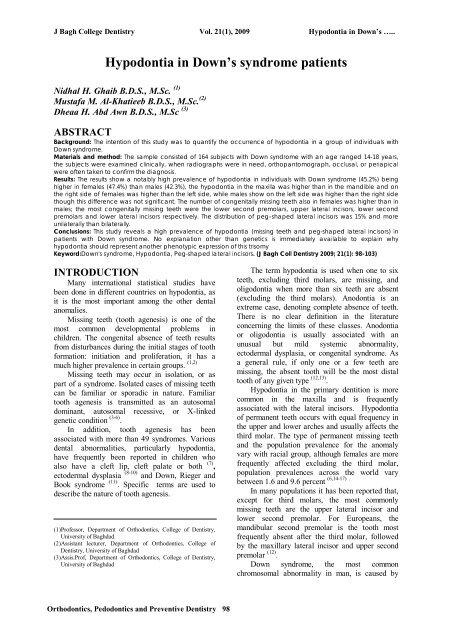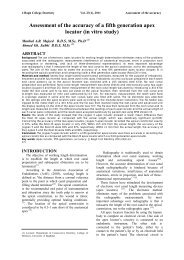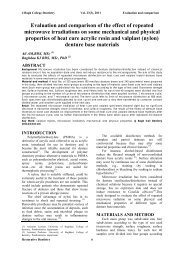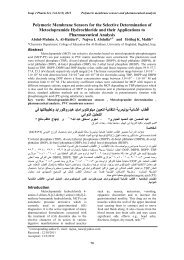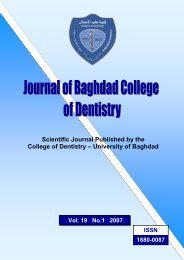Vol 21 No. 1
Vol 21 No. 1
Vol 21 No. 1
Create successful ePaper yourself
Turn your PDF publications into a flip-book with our unique Google optimized e-Paper software.
J Bagh College Dentistry <strong>Vol</strong>. <strong>21</strong>(1), 2009 Hypodontia in Down’s …..<br />
Hypodontia in Down’s syndrome patients<br />
Nidhal H. Ghaib B.D.S., M.Sc. (1)<br />
Mustafa M. Al-Khatieeb B.D.S., M.Sc. (2)<br />
Dheaa H. Abd Awn B.D.S., M.Sc (3)<br />
ABSTRACT<br />
Background: The intention of this study was to quantify the occurrence of hypodontia in a group of individuals with<br />
Down syndrome.<br />
Materials and method: The sample consisted of 164 subjects with Down syndrome with an age ranged 14-18 years,<br />
the subjects were examined clinically, when radiographs were in need, orthopantomograph, occlusal, or periapical<br />
were often taken to confirm the diagnosis.<br />
Results: The results show a notably high prevalence of hypodontia in individuals with Down syndrome (45.2%) being<br />
higher in females (47.4%) than males (42.3%), the hypodontia in the maxilla was higher than in the mandible and on<br />
the right side of females was higher than the left side, while males show on the left side was higher than the right side<br />
though this difference was not significant. The number of congenitally missing teeth also in females was higher than in<br />
males; the most congenitally missing teeth were the lower second premolars, upper lateral incisors, lower second<br />
premolars and lower lateral incisors respectively. The distribution of peg–shaped lateral incisors was 15% and more<br />
unilaterally than bilaterally.<br />
Conclusions: This study reveals a high prevalence of hypodontia (missing teeth and peg-shaped lateral incisors) in<br />
patients with Down syndrome. <strong>No</strong> explanation other than genetics is immediately available to explain why<br />
hypodontia should represent another phenotypic expression of this trisomy<br />
Keyword:Down's syndrome, Hypodontia, Peg-shaped lateral incisors. (J Bagh Coll Dentistry 2009; <strong>21</strong>(1): 98-103)<br />
INTRODUCTION<br />
Many international statistical studies have<br />
been done in different countries on hypodontia, as<br />
it is the most important among the other dental<br />
anomalies.<br />
Missing teeth (tooth agenesis) is one of the<br />
most common developmental problems in<br />
children. The congenital absence of teeth results<br />
from disturbances during the initial stages of tooth<br />
formation: initiation and proliferation, it has a<br />
much higher prevalence in certain groups. (1,2)<br />
Missing teeth may occur in isolation, or as<br />
part of a syndrome. Isolated cases of missing teeth<br />
can be familiar or sporadic in nature. Familiar<br />
tooth agenesis is transmitted as an autosomal<br />
dominant, autosomal recessive, or X-linked<br />
genetic condition (3-6) .<br />
In addition, tooth agenesis has been<br />
associated with more than 49 syndromes. Various<br />
dental abnormalities, particularly hypodontia,<br />
have frequently been reported in children who<br />
also have a cleft lip, cleft palate or both (7) ,<br />
ectodermal dysplasia (8-10) and Down, Rieger and<br />
Book syndrome (11) . Specific terms are used to<br />
describe the nature of tooth agenesis.<br />
(1)Professor, Department of Orthodontics, College of Dentistry,<br />
University of Baghdad.<br />
(2)Assistant lecturer, Department of Orthodontics, College of<br />
Dentistry, University of Baghdad<br />
(3)Assis.Prof, Department of Orthodontics, College of Dentistry,<br />
University of Baghdad<br />
The term hypodontia is used when one to six<br />
teeth, excluding third molars, are missing, and<br />
oligodontia when more than six teeth are absent<br />
(excluding the third molars). Anodontia is an<br />
extreme case, denoting complete absence of teeth.<br />
There is no clear definition in the literature<br />
concerning the limits of these classes. Anodontia<br />
or oligodontia is usually associated with an<br />
unusual but mild systemic abnormality,<br />
ectodermal dysplasia, or congenital syndrome. As<br />
a general rule, if only one or a few teeth are<br />
missing, the absent tooth will be the most distal<br />
tooth of any given type (12,13) .<br />
Hypodontia in the primary dentition is more<br />
common in the maxilla and is frequently<br />
associated with the lateral incisors. Hypodontia<br />
of permanent teeth occurs with equal frequency in<br />
the upper and lower arches and usually affects the<br />
third molar. The type of permanent missing teeth<br />
and the population prevalence for the anomaly<br />
vary with racial group, although females are more<br />
frequently affected excluding the third molar,<br />
population prevalences across the world vary<br />
between 1.6 and 9.6 percent (6,14-17) .<br />
In many populations it has been reported that,<br />
except for third molars, the most commonly<br />
missing teeth are the upper lateral incisor and<br />
lower second premolar. For Europeans, the<br />
mandibular second premolar is the tooth most<br />
frequently absent after the third molar, followed<br />
by the maxillary lateral incisor and upper second<br />
premolar (12) .<br />
Down syndrome, the most common<br />
chromosomal abnormality in man, is caused by<br />
Orthodontics, Pedodontics and Preventive Dentistry 98


